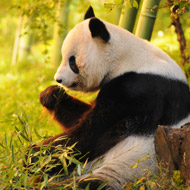Giant panda habitat shrinking, study finds

Researchers used satellite imagery to examine changes across the panda’s entire geographic range.
The giant panda’s habitat is shrinking and becoming more fragmented, new research has found.
Scientists say the species’ natural terrain has decreased by 23 per cent since 1976. An increase in roads and other infrastructure have been the major factor in fragmenting this habitat, they stress.
The study used geospatial technologies and remote sensing data to map recent land-use changes and developments within the panda’s territory. Results are published in the journal Nature Ecology and Evolution.
“The International Union for Conservation of Nature (IUCN) has recently changed the status of the giant panda from ‘endangered’ to the less threatened ‘vulnerable,’” said Stuart L. Pimm, professor of conservation ecology at Duke University. “This was based on the increasing numbers, which are a very encouraging sign, of course.”
“But what my colleagues and I wanted to know was how the panda’s habitat has changed over the last four decades, because the extent and connectivity of a species’ habitat is also a major factor in determining its risk of extinction.”
In the study, researchers used satellite imagery to examine changes across the panda’s entire geographic range from 1976 to 2001. The team found that the average size of the habitat fell by 23 per cent over this period.
But it’s not all bad news. Researchers did note a slight increase in habitat size since 2001, largely due some of the changes that have occurred in the region.
“Banning commercial logging in natural forests, establishing nature reserves and helping residents in the reserve change behaviours that damaged habitat has been beneficial,” notes co-author Jianguo Liu of Michigan State University. “But conservation is a dynamic process with humans and nature in a constant push and pull to survive and thrive, so new solutions always are in demand.”
Other changes highlighted by the study present challenges from a conservation standpoint. The most obvious being the increase and improvement in roads and other infrastructure.
“These have been the major factor in fragmenting the habitat. There was nearly three times the density of roads in 2013 than in 1976,” said Professor Zhiyum Ouyang, also from Michigan State University. “We suggest several solutions. One of the most important will be to establish protected corridors through which pandas can move to prevent their isolation into small and unsustainable populations.”



 BSAVA is to partner with BVA Live (11-12 June 2026) to champion clinical research.
BSAVA is to partner with BVA Live (11-12 June 2026) to champion clinical research.